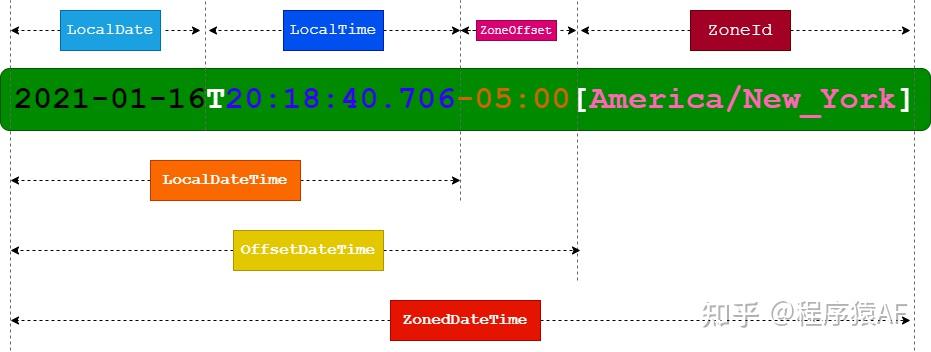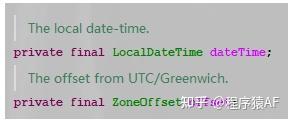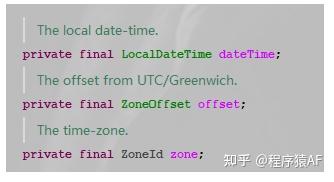LocalDateTime、OffsetDateTime、ZonedDateTime互转,请看这一篇

前言
在JSR 310日期时间体系了,一共有三个API可用于表示日期时间:
- LocalDateTime:本地日期时间
- OffsetDateTime:带偏移量的日期时间
- ZonedDateTime:带时区的日期时间
也许平时开发中你只用到过LocalDateTime这个API,那是极好的,但是不能止步于此,否则就图样图森破了。
随着场景的多样性变化,咱们开发者接触到OffsetDateTime/ZonedDateTime的概率越来越大,但凡和国际化产生上关系的大概率都会用得到它们。本文依然站在实用的角度,辅以具体代码示例,介绍它三。
本文提纲

版本约定
- JDK:8
正文
下面这张图是一个 完整 的日期时间,拆解各个部分的含义,一目了然(建议收藏此图):

因为LocalDate、LocalTime等理解起来比较简单,就不用再花笔墨介绍了,重点放在LocalDateTime、OffsetDateTime、ZonedDateTime它三身上。
什么是LocalDateTime?

ISO-8601日历系统中 不带时区 的日期时间。
说明:ISO-8601日系统是现今世界上绝大部分国家/地区使用的,这就是我们国人所说的公历,有闰年的特性
LocalDateTime是一个不可变的日期-时间对象,它表示一个日期时间,通常被视为 年-月-日-小时-分钟-秒 。还可以访问其他日期和时间字段,如day-of-year、day-of-week和week-of-year等等,它的精度能达纳秒级别。
该类不存储时区,所以适合日期的描述,比如用于生日、deadline等等。但是请记住,如果没有偏移量/时区等附加信息,一个时间是 不能 表示时间线上的某一时刻的。
代码示例
最大/最小值:
@Test
public void test1() {
LocalDateTime min = LocalDateTime.MIN;
LocalDateTime max = LocalDateTime.MAX;
System.out.println("LocalDateTime最小值:" + min);
System.out.println("LocalDateTime最大值:" + max);
System.out.println(min.getYear() + "-" + min.getMonthValue() + "-" + min.getDayOfMonth());
System.out.println(max.getYear() + "-" + max.getMonthValue() + "-" + max.getDayOfMonth());
LocalDateTime最小值:-999999999-01-01T00:00
LocalDateTime最大值:+999999999-12-31T23:59:59.999999999
-999999999-1-1
999999999-12-31构造:
@Test
public void test2() {
System.out.println("当前时区的本地时间:" + LocalDateTime.now());
System.out.println("当前时区的本地时间:" + LocalDateTime.of(LocalDate.now(), LocalTime.now()));
System.out.println("纽约时区的本地时间:" + LocalDateTime.now(ZoneId.of("America/New_York")));
当前时区的本地时间:2021-01-17T17:00:41.446
当前时区的本地时间:2021-01-17T17:00:41.447
纽约时区的本地时间:2021-01-17T04:00:41.450注意,最后一个构造传入了ZoneId,并不是说LocalDateTime和时区有关了,而是告诉说这个 Local指的是纽约 ,细品这句话。
计算:
@Test
public void test3() {
LocalDateTime now = LocalDateTime.now(ZoneId.systemDefault());
System.out.println("计算前:" + now);
// 加3天
LocalDateTime after = now.plusDays(3);
// 减4个小时
after = after.plusHours(-3); // 效果同now.minusDays(3);
System.out.println("计算后:" + after);
// 计算时间差
Period period = Period.between(now.toLocalDate(), after.toLocalDate());
System.out.println("相差天数:" + period.getDays());
Duration duration = Duration.between(now.toLocalTime(), after.toLocalTime());
System.out.println("相差小时数:" + duration.toHours());
计算前:2021-01-17T17:10:15.381
计算后:2021-01-20T14:10:15.381
相差天数:3
相差小时数:-3格式化:
@Test
public void test4() {
LocalDateTime now = LocalDateTime.now(ZoneId.systemDefault());
// System.out.println("格式化输出:" + DateTimeFormatter.ISO_LOCAL_DATE_TIME.format(now));
System.out.println("格式化输出(本地化输出,中文环境):" + DateTimeFormatter.ofLocalizedDateTime(FormatStyle.SHORT, FormatStyle.SHORT).format(now));
String dateTimeStrParam = "2021-01-17 18:00:00";
System.out.println("解析后输出:" + LocalDateTime.parse(dateTimeStrParam, DateTimeFormatter.ofPattern("yyyy-MM-dd HH:mm:ss", Locale.US)));
格式化输出(本地化输出,中文环境):21-1-17 下午5:15
解析后输出:2021-01-17T18:00什么是OffsetDateTime?

ISO-8601日历系统中与UTC偏移量有关的日期时间。OffsetDateTime是一个 带有偏移量 的日期时间类型。存储有精确到纳秒的日期时间,以及偏移量。可以简单理解为 OffsetDateTime = LocalDateTime + ZoneOffset。

OffsetDateTime、ZonedDateTime和Instant它们三都能在时间线上以纳秒精度存储一个瞬间(请注意:LocalDateTime是不行的),也可理解我某个时刻。OffsetDateTime和Instant可用于模型的字段类型,因为它们都表示瞬间值并且还不可变,所以适合网络传输或者数据库持久化。
ZonedDateTime不适合网络传输/持久化,因为即使同一个ZoneId时区,不同地方获取到瞬时值也有可能不一样
代码示例
最大/最小值:
@Test
public void test5() {
OffsetDateTime min = OffsetDateTime.MIN;
OffsetDateTime max = OffsetDateTime.MAX;
System.out.println("OffsetDateTime最小值:" + min);
System.out.println("OffsetDateTime最大值:" + max);
System.out.println(min.getOffset() + ":" + min.getYear() + "-" + min.getMonthValue() + "-" + min.getDayOfMonth());
System.out.println(max.getOffset() + ":" + max.getYear() + "-" + max.getMonthValue() + "-" + max.getDayOfMonth());
OffsetDateTime最小值:-999999999-01-01T00:00+18:00
OffsetDateTime最大值:+999999999-12-31T23:59:59.999999999-18:00
+18:00:-999999999-1-1
-18:00:999999999-12-31偏移量的最大值是+18,最小值是-18,这是由ZoneOffset内部的限制决定的。
构造:
@Test
public void test6() {
System.out.println("当前位置偏移量的本地时间:" + OffsetDateTime.now());
System.out.println("偏移量-4(纽约)的本地时间::" + OffsetDateTime.of(LocalDateTime.now(), ZoneOffset.of("-4")));
System.out.println("纽约时区的本地时间:" + OffsetDateTime.now(ZoneId.of("America/New_York")));
当前位置偏移量的本地时间:2021-01-17T19:02:06.328+08:00
偏移量-4(纽约)的本地时间::2021-01-17T19:02:06.329-04:00
纽约时区的本地时间:2021-01-17T06:02:06.330-05:00
计算:
略
格式化:
@Test
public void test7() {
OffsetDateTime now = OffsetDateTime.now(ZoneId.systemDefault());
System.out.println("格式化输出(本地化输出,中文环境):" + DateTimeFormatter.ofLocalizedDateTime(FormatStyle.SHORT, FormatStyle.SHORT).format(now));
String dateTimeStrParam = "2021-01-17T18:00:00+07:00";
System.out.println("解析后输出:" + OffsetDateTime.parse(dateTimeStrParam));
格式化输出(本地化输出,中文环境):21-1-17 下午7:06
解析后输出:2021-01-17T18:00+07:00
转换:
LocalDateTime -> OffsetDateTime
@Test
public void test8() {
LocalDateTime localDateTime = LocalDateTime.of(2021, 01, 17, 18, 00, 00);
System.out.println("当前时区(北京)时间为:" + localDateTime);
// 转换为偏移量为 -4的OffsetDateTime时间
// 1、-4地方的晚上18点
System.out.println("-4偏移量地方的晚上18点:" + OffsetDateTime.of(localDateTime, ZoneOffset.ofHours(-4)));
System.out.println("-4偏移量地方的晚上18点(方式二):" + localDateTime.atOffset(ZoneOffset.ofHours(-4)));
// 2、北京时间晚上18:00 对应的-4地方的时间点
System.out.println("当前地区对应的-4地方的时间:" + OffsetDateTime.ofInstant(localDateTime.toInstant(ZoneOffset.ofHours(8)), ZoneOffset.ofHours(-4)));
当前时区(北京)时间为:2021-01-17T18:00
-4偏移量地方的晚上18点:2021-01-17T18:00-04:00
-4偏移量地方的晚上18点(方式二):2021-01-17T18:00-04:00
当前地区对应的-4地方的时间:2021-01-17T06:00-04:00
通过此例值得注意的是:
LocalDateTime#atOffset()/atZone()
只是增加了偏移量/时区,本地时间是并没有改变的。若想实现本地时间到其它偏移量的
对应的
时间只能通过其
ofInstant()
系列构造方法。
OffsetDateTime -> LocalDateTime
@Test
public void test81() {
OffsetDateTime offsetDateTime = OffsetDateTime.of(LocalDateTime.now(), ZoneOffset.ofHours(-4));
System.out.println("-4偏移量时间为:" + offsetDateTime);
// 转为LocalDateTime 注意:时间还是未变的哦
System.out.println("LocalDateTime的表示形式:" + offsetDateTime.toLocalDateTime());
-4偏移量时间为:2021-01-17T19:33:28.139-04:00
LocalDateTime的表示形式:2021-01-17T19:33:28.139什么是ZonedDateTime?

ISO-8601国际标准日历系统中 带有时区 的日期时间。它存储所有的日期和时间字段,精度为纳秒,以及一个时区,带有用于处理不明确的本地日期时间的时区偏移量。
这个API可以处理从
LocalDateTime -> Instant -> ZonedDateTime
的转换,其中用zone时区来表示偏移量(并非直接用offset哦)。两个时间点之间的转换会涉及到使用从ZoneId访问的
规则计算
偏移量(换句话说:偏移量并非写死而是根据规则计算出来的)。
获取瞬间的偏移量很简单,因为每个瞬间只有一个有效的偏移量。但是,获取本地日期时间的偏移量并不简单。存在这三种情况:
- 正常情况:有一个有效的偏移量。对于一年中的绝大多数时间,适用正常情况,即本地日期时间只有一个有效的偏移量
- 时间间隙情况:没有有效偏移量。这是由于夏令时开始时从“冬季”改为“夏季”而导致时钟向前拨的时候。 在间隙中 ,没有有效偏移量
- 重叠情况:有两个有效偏移量。这是由于秋季夏令时从“夏季”到“冬季”的变化,时钟会向后拨。在重叠部分中,有两个有效偏移量
这三种情况如果要自己处理,估计头都大了。这就是使用JSR 310的优势,ZonedDateTime全帮你搞定,让你使用无忧。
ZonedDateTime可简单认为是 LocalDateTime和ZoneId的组合 。而ZoneOffset是其内置的动态计算出来的一个次要信息,以确保输出一个瞬时值而存在,毕竟在某个瞬间偏移量ZoneOffset肯定是确定的。ZonedDateTime也可以理解为保存的状态相当于三个独立的对象:LocalDateTime、ZoneId和ZoneOffset。某个瞬间 = LocalDateTime + ZoneOffset。ZoneId确定了偏移量如何改变的规则。所以偏移量我们 并不能 自由设置(不提供set方法,构造时也不行),因为它由ZoneId来控制的。

代码示例
构造:
@Test
public void test9() {
System.out.println("当前位置偏移量的本地时间:" + ZonedDateTime.now());
System.out.println("纽约时区的本地时间:" + ZonedDateTime.of(LocalDateTime.now(), ZoneId.of("America/New_York")));
System.out.println("北京实现对应的纽约时区的本地时间:" + ZonedDateTime.now(ZoneId.of("America/New_York")));
当前位置偏移量的本地时间:2021-01-17T19:25:10.520+08:00[Asia/Shanghai]
纽约时区的本地时间:2021-01-17T19:25:10.521-05:00[America/New_York]
北京实现对应的纽约时区的本地时间:2021-01-17T06:25:10.528-05:00[America/New_York]
计算:
略
格式化:
略
转换:
LocalDateTime -> ZonedDateTime
@Test
public void test10() {
LocalDateTime localDateTime = LocalDateTime.of(2021, 01, 17, 18, 00, 00);
System.out.println("当前时区(北京)时间为:" + localDateTime);
// 转换为偏移量为 -4的OffsetDateTime时间
// 1、-4地方的晚上18点
System.out.println("纽约时区晚上18点:" + ZonedDateTime.of(localDateTime, ZoneId.of("America/New_York")));
System.out.println("纽约时区晚上18点(方式二):" + localDateTime.atZone(ZoneId.of("America/New_York")));
// 2、北京时间晚上18:00 对应的-4地方的时间点
System.out.println("北京地区此时间对应的纽约的时间:" + ZonedDateTime.ofInstant(localDateTime.toInstant(ZoneOffset.ofHours(8)), ZoneOffset.ofHours(-4)));
System.out.println("北京地区此时间对应的纽约的时间:" + ZonedDateTime.ofInstant(localDateTime, ZoneOffset.ofHours(8), ZoneOffset.ofHours(-4)));
当前时区(北京)时间为:2021-01-17T18:00
纽约时区晚上18点:2021-01-17T18:00-05:00[America/New_York]
纽约时区晚上18点(方式二):2021-01-17T18:00-05:00[America/New_York]
北京地区此时间对应的纽约的时间:2021-01-17T06:00-04:00
北京地区此时间对应的纽约的时间:2021-01-17T06:00-04:00OffsetDateTime -> ZonedDateTime
@Test
public void test101() {
OffsetDateTime offsetDateTime = OffsetDateTime.of(LocalDateTime.now(), ZoneOffset.ofHours(-4));
System.out.println("-4偏移量时间为:" + offsetDateTime);
// 转换为ZonedDateTime的表示形式
System.out.println("ZonedDateTime的表示形式:" + offsetDateTime.toZonedDateTime());
System.out.println("ZonedDateTime的表示形式:" + offsetDateTime.atZoneSameInstant(ZoneId.of("America/New_York")));
System.out.println("ZonedDateTime的表示形式:" + offsetDateTime.atZoneSimilarLocal(ZoneId.of("America/New_York")));
-4偏移量时间为:2021-01-17T19:43:28.320-04:00
ZonedDateTime的表示形式:2021-01-17T19:43:28.320-04:00
ZonedDateTime的表示形式:2021-01-17T18:43:28.320-05:00[America/New_York]
ZonedDateTime的表示形式:2021-01-17T19:43:28.320-05:00[America/New_York]本例有值得关注的点:
-
atZoneSameInstant():将此日期时间与时区结合起来创建ZonedDateTime,以确保结果具有 相同的Instant - 所有偏移量-4 -> -5,时间点也从19 -> 18,确保了Instant保持一致嘛
-
atZoneSimilarLocal:将此日期时间与时区结合起来创建ZonedDateTime,以确保结果具有 相同的本地时间 - 所以直接效果和toLocalDateTime()是一样的,但是它会尽可能的保留偏移量(所以你看-4变为了-5,保持了真实的偏移量)
我这里贴出纽约2021年的夏令时时间区间:

image.png
也就是说在2021.03.14 - 2021.11.07期间,纽约的偏移量是-4,其余时候是-5。那么再看这个例子(我把时间改为5月5号,也就是处于夏令营期间):
@Test
public void test101() {
OffsetDateTime offsetDateTime = OffsetDateTime.of(LocalDateTime.of(2021, 05, 05, 18, 00, 00), ZoneOffset.ofHours(-4));
System.out.println("-4偏移量时间为:" + offsetDateTime);
// 转换为ZonedDateTime的表示形式
System.out.println("ZonedDateTime的表示形式:" + offsetDateTime.toZonedDateTime());
System.out.println("ZonedDateTime的表示形式:" + offsetDateTime.atZoneSameInstant(ZoneId.of("America/New_York")));
System.out.println("ZonedDateTime的表示形式:" + offsetDateTime.atZoneSimilarLocal(ZoneId.of("America/New_York")));
